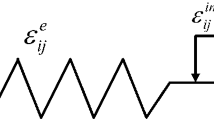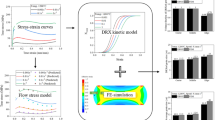Abstract
Fully coupled thermomechanical models for Nitinol at the grain level are developed in this work to capture the inter-dependence between deformation and temperature under non-isothermal conditions. The martensite transformation equations are solved using a novel algorithm which imposes all relevant constraints on the volume fractions. The numerical implementation of the resulting models within the finite element method is effected by the monolithic solution of the momentum and energy equations. Validation of the models is achieved by means of thin-tube experiments at different strain rates.
Similar content being viewed by others
References
Siredey N, Patoor E, Berveiller M, Eberhardt A (1999) Constitutive equations for polycrystalline thermoelastic shape memory alloys. Part I. Intragranular interactions and behavior of the grain. Int J Solids Struct 36: 4289–4315
Gao X, Huang M, Brinson LC (2000) A multivariant micromechanical model for SMAs part 1. crystallographic issues for the single crystal model. Int J Plast 16: 1345–1369
Govindjee S, Miehe C (2001) A multi-variant martensitic phase transformation model: formulation and numerical implementation. Comput Methods Appl Mech Eng 191: 215–238
Patoor E, Lagoudas DC, Entchev PB, Brinson LC, Gao X (2006) Shape memory alloys, part I: general properties and modeling of single crystals. Mech Mater 38: 391–429
Anand L, Gurtin ME (2003) Thermal effects in the superelasticity of crystalline shape-memory materials. J Mech Phys Solids 51: 1015–1058
Turtletaub S, Suiker ASJ (2006) A multiscale thermomechanical model for cubic to tetragonal martensitic phase transformations. Int J Sol Struct 43: 4509–4545
Stein E, Sagar G (2007) Theory and finite element computation of cyclic martensitic phase transformation at finite strain. Int J Numer Methods Eng 74: 1–31
Govindjee S, Hall GJ (2000) A computational model for shape memory alloys. Int J Solids Struct 37: 735–760
Jung Y, Papadopoulos P, Ritchie RO (2004) Constitutive modelling and numerical simulation of multivariant phase transformation in superelastic shape-memory alloys. Int J Numer Methods Eng 60: 429–460
Sengupta A, Papadopoulos P (2011) A note on the use of multiplicative decomposition for displacive phase transformations. Int J Eng Sci (accepted)
Mandel J (1973) Thermodynamics and plasticity. In: Foundations of continuum thermodynamics. Macmillan, New York, pp 283–304
Christ D, Reese S (2009) A finite element model for shape memory alloys considering thermomechanical couplings at large strains. Int J Solids Struct 46: 3694–3709
Thamburaja P, Anand L (2001) Polycrystalline shape-memory materials: effect of crystallographic texture. J Mech Phys Solids 49: 709–737
Entemeyer D, Patoor E, Eberhardt E, Berveiller A (2000) Strain rate sensitivity in superelasticity. Int J Plast 16: 1269–1288
Nemat-Nasser S, Choi JY, Guo WG, Isaacs JB, Taya M (2005) High strain-rate, small strain response of a NiTi shape-memory alloy. J Eng Mater Technol 127: 83–89
Grabe C, Bruhns OT (2008) On the viscous and strain rate dependent behavior of polycrystalline NiTi. Int J Solids Struct 45: 1876–1895
Helm D, Haupt P (2003) Shape memory behaviour: modelling within continuum thermomechanics. Int J Solids Struct 40: 827–849
Taylor RL (2008) FEAP—a finite element analysis program: users manual. University of California, Berkeley. http://www.ce.berkeley.edu/rlt
Holman JP (1990) Heat transfer. McGraw-Hill, New York
McNaney JM, Imbeni V, Jung Y, Papadopoulos P, Ritchie RO (2003) An experimental study of the superelastic effect in a shape-memory nitinol alloy under biaxial loading. Mech Mat 35: 969–986
Duerig TW, Pelton AR (1994) Ti-Ni shape memory alloys. In: Materials properties handbook titanium alloys, pp 1035–1048
Johnson Matthey Medical. Nitinol technical properties. http://jmmedical.com/resources/221/Nitinol-Technical-Properties.html (2009)
Papadopoulos P, Sengupta A, Taylor RL (2011) A multiscale finite-element method for modeling fully-coupled thermomechanical problems in solids (in press)
Sengupta A, Papadopoulos P (2009) Constitutive modeling and finite element approximation of B2-R-B19’ phase transformations in Nitinol polycrystals. Comput Methods Appl Mech Eng 198: 3214–3227
Author information
Authors and Affiliations
Corresponding author
Rights and permissions
About this article
Cite this article
Sengupta, A., Papadopoulos, P., Kueck, A. et al. On phase transformation models for thermo-mechanically coupled response of Nitinol. Comput Mech 48, 213–227 (2011). https://doi.org/10.1007/s00466-011-0587-4
Received:
Accepted:
Published:
Issue Date:
DOI: https://doi.org/10.1007/s00466-011-0587-4




